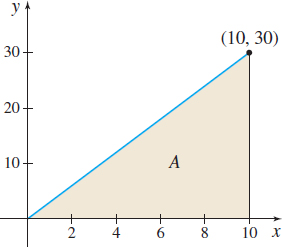EXAMPLE 3Finding Area Using Upper Sums
Find the area \(A\) under the graph of \(f(x) = 3x\) from \(0\) to \(10\) using upper sums \(S_{n}\) (rectangles that lie above the graph of \(f)\). Then \(A = \lim\limits_{n\rightarrow \infty }S_{n}\).

Solution Figure 12 illustrates the area \(A\). We partition the closed interval \([0,10]\) into \(n\) subintervals \[ {[{x_{0},x_{1}}]}, {[{x_{1},x_{2}}]}, \ldots, [x_{i-1},x_{i}] , \ldots , {{[{x_{n-1},x_{n}}]}} \]
where \[ 0=x_{0}\lt x_{1}\lt x_{2}\lt \cdots \lt x_{i}\lt \cdots \lt x_{n-1}\lt x_{n}=10 \]
and each subinterval is of length \[ \Delta x = {\dfrac{{10 - 0}}{{n}}} = {\dfrac{{10}}{{n}}} \]
The coordinates of the endpoints of each subinterval, written in terms of \(n,\) are \[ \begin{eqnarray*} x_{0} &=& 0,\ x_{1}={\dfrac{{10}}{{n}}},\ x_{2}=2\left( {{\dfrac{{10}}{{n}}}}\right), \ldots , x_{i-1}=(i-1) \left( {{\dfrac{{10}}{{n}}}}\right), \\ x_{i} &=& i\left( {{\dfrac{{10}}{{n}}}}\right), \ldots , x_{n}=n\left( {{\dfrac{{10}}{{n}}}}\right) =10 \end{eqnarray*} \]
as illustrated in Figure 13.
349
To find \(A\) using upper sums \(S_{n}\) (rectangles that lie above the graph of \(f)\), we need the absolute maximum value of \(f\) in each subinterval. Since \(f(x)=3x\) is an increasing function, the absolute maximum occurs at the right endpoint \(x_{i}= i\left(\dfrac{10}{n}\right) \) of each subinterval. So,
Summation properties are discussed in Appendix A.5, pp. A-38 to A-43.
\[ \begin{eqnarray*} S_{n}=\sum\limits_{i=1}^{n} f (C_i)\Delta x \underset{\underset{{\color{#0066A7}{\hbox{\( \Delta x = \dfrac{10}{n}\)}}}}{\color{#0066A7}{\uparrow}}}{=} \sum \limits_{i=1}^{n}3x_{i}\cdot \dfrac{10}{n} \underset{\underset{{\color{#0066A7}{\hbox{\( {x}_{i} = \dfrac{10i}{n}\)}}}}{\color{#0066A7}{\uparrow}}}{=} {\sum\limits_{i=1}^{n}}\left( 3\cdot \dfrac{10i}{n}\right) \left( \dfrac{10}{n}\right) = \sum\limits_{i=1}^{n}\dfrac{300}{n^2}i \end{eqnarray*} \]
Using summation properties, we get
\(\sum\limits_{i=1}^{n}i=\dfrac{n(n+1) }{2}\)
\[ S_{n}= \sum\limits_{i=1}^{n} \dfrac{300}{n^2} i =\dfrac{300}{n^2} \sum\limits_{i=1}^{n} i = \dfrac{300}{n^2}\ \dfrac{n(n+1)}{2} = 150\left(\dfrac{n+1}{n}\right) =150\left(1+\dfrac{1}{n}\right) \]
Then \[ A=\lim\limits_{n\rightarrow \infty }S_{n}=\lim\limits_{n\rightarrow \infty } \left[150 \left( 1+\dfrac{1}{n} \right) \right] =150\lim\limits_{n\rightarrow \infty }\left(1+\dfrac{1}{n}\right) = 150 \]
The area \(A\) under the graph of \(f(x)=3x\) from \(0\) to \(10\) is \(150\) square units.
